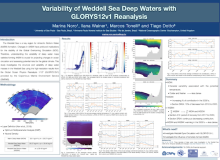Variability of Weddell Sea Deep Water in GLORYS12v1 Reanalysis
ILANA
WAINER
Oceanographic Institute, University of São Paulo, São Paulo, Brazil
Poster
Antarctic Bottom Water (AABW) play a crucial role in the intensity and variability of the Global
Overturning Circulation (GOC) by feeding its lower limb. Changes in AABW have far-reaching
implications for the stability of the GOC. Therefore, understanding the variability of deep water mass
varieties forming AABW is crucial for projecting changes in ocean circulation and assess potential
risks for the global climate. The study of Antarctic deep water masses and AABW formation processes
has been challenging due to limited observational data products and the numerical complexities of
integrating processes at different scales. However, recent high-resolution oceanic products offer a
promising opportunity to improve our understanding about this region. In this study, we investigate the
structure and variability of deep water masses in the Weddell Sea using the Global Ocean Physics
Reanalysis 1/12° (GLORYS12V1) product provided by the Copernicus Marine Environment Service
(CMEMS) spanning from 1993 to 2020. The analysis were performed in two transects, corresponding
to the locations of WOCE A12, along the Prime Meridian, and S04 in the inner Weddell Sea. Results
from GLORYS12v1 showed an increasing contribution of Warm Deep Water (WDW) starting in 2000.
WDW also exhibited a cooler and fresher trend from 1993 to 2020. The decrease in WDW temperature
could weaken the gradient between WDW and shelf waters in the formation areas, potentially leading
to the intrusion of warmer waters to the shelf. Further analyses are required to assess coastal dynamics
and the impact of WDW on formation areas. However, the results indicated that WSDW became
warmer starting in 2000, and WSBW exhibited a warming trend from 2005. In section S04, which is
closer to the formation areas, a decrease of 10% in the contribution of WSDW was observed over the
last three years, and a gradual 4% decrease in the contribution of WSBW occurred from 1993 to 2020.
In section A12, despite the warming, it experienced an increasing contribution of about 12% for
WSDW from 2004 to 2020 and 8% for WSBW in the last three years. Section A12 is influenced by
both locally formed WSDW and WSBW that recirculate and external AABW varieties entering the
Weddell Sea. These external influences were not assessed in this study, highlighting the need for future
research to consider the dynamics of the Weddell Gyre, and input from other sources.
Overturning Circulation (GOC) by feeding its lower limb. Changes in AABW have far-reaching
implications for the stability of the GOC. Therefore, understanding the variability of deep water mass
varieties forming AABW is crucial for projecting changes in ocean circulation and assess potential
risks for the global climate. The study of Antarctic deep water masses and AABW formation processes
has been challenging due to limited observational data products and the numerical complexities of
integrating processes at different scales. However, recent high-resolution oceanic products offer a
promising opportunity to improve our understanding about this region. In this study, we investigate the
structure and variability of deep water masses in the Weddell Sea using the Global Ocean Physics
Reanalysis 1/12° (GLORYS12V1) product provided by the Copernicus Marine Environment Service
(CMEMS) spanning from 1993 to 2020. The analysis were performed in two transects, corresponding
to the locations of WOCE A12, along the Prime Meridian, and S04 in the inner Weddell Sea. Results
from GLORYS12v1 showed an increasing contribution of Warm Deep Water (WDW) starting in 2000.
WDW also exhibited a cooler and fresher trend from 1993 to 2020. The decrease in WDW temperature
could weaken the gradient between WDW and shelf waters in the formation areas, potentially leading
to the intrusion of warmer waters to the shelf. Further analyses are required to assess coastal dynamics
and the impact of WDW on formation areas. However, the results indicated that WSDW became
warmer starting in 2000, and WSBW exhibited a warming trend from 2005. In section S04, which is
closer to the formation areas, a decrease of 10% in the contribution of WSDW was observed over the
last three years, and a gradual 4% decrease in the contribution of WSBW occurred from 1993 to 2020.
In section A12, despite the warming, it experienced an increasing contribution of about 12% for
WSDW from 2004 to 2020 and 8% for WSBW in the last three years. Section A12 is influenced by
both locally formed WSDW and WSBW that recirculate and external AABW varieties entering the
Weddell Sea. These external influences were not assessed in this study, highlighting the need for future
research to consider the dynamics of the Weddell Gyre, and input from other sources.

wainer-ilana-polar-poster.pdf
(5.75 MB)
